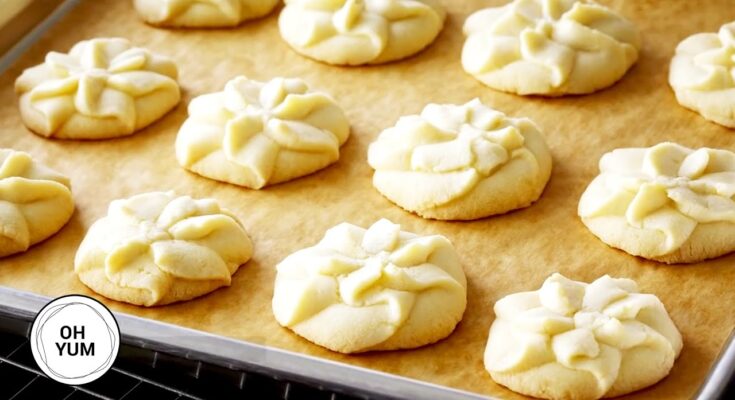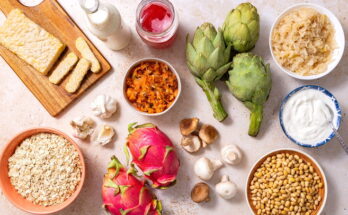Shortbread Cookie Recipe: Shortbread cookies are a classic, buttery delight that melt in your mouth with each bite. Simple in ingredients but rich in flavor, shortbread is easy to make and perfect for any occasion.
This step-by-step guide will help you create perfect shortbread cookies every time. Let’s dive into the recipe!
Ingredients Needed for Shortbread Cookies
Before you begin, gather these essential ingredients:
- 1 cup (2 sticks) unsalted butter, at room temperature
- 1/2 cup granulated sugar
- 1/4 cup powdered sugar (for a smoother texture)
- 1/4 teaspoon salt
- 2 cups all-purpose flour
- Optional: Vanilla extract, almond extract, or a pinch of cinnamon for extra flavor
Equipment Needed
- Mixing bowl
- Hand mixer or stand mixer
- Measuring cups and spoons
- Baking sheet
- Parchment paper or silicone baking mat
- Rolling pin
- Cookie cutters (optional)
Step-by-Step Shortbread Cookie Recipe
Step 1: Prepare the Ingredients
- Room Temperature Butter: Take the butter out of the fridge at least 30 minutes before you start to soften it. This will help it mix smoothly with the sugars.
- Preheat the Oven: Set your oven to 325°F (160°C) so it’s ready to go when your dough is.
Step 2: Cream the Butter and Sugars
- Combine Butter and Sugars: In a large mixing bowl, add the softened butter, granulated sugar, and powdered sugar.
- Beat Until Fluffy: Use a hand mixer or stand mixer to beat the ingredients until light and fluffy, about 2–3 minutes. This step is crucial for achieving a delicate texture in your shortbread.
Step 3: Add Salt and Flavorings
- Add Salt and Optional Flavoring: Sprinkle in the salt and, if desired, a splash of vanilla or almond extract for extra flavor.
- Mix Again: Mix briefly to incorporate the salt and flavorings evenly.
Step 4: Add the Flour Gradually
- Add Flour in Batches: Sift the flour, then gradually add it to the butter mixture in batches, mixing slowly after each addition.
- Avoid Overmixing: Stop mixing as soon as the flour is fully incorporated. Overmixing can make the cookies tough.
Step 5: Shape the Dough
- Form Dough into a Disk: Gently gather the dough into a ball with your hands and flatten it into a disk.
- Wrap and Chill: Wrap the dough in plastic wrap and refrigerate for 30 minutes. Chilling helps the dough firm up, making it easier to roll and cut.
Step 6: Roll Out and Cut the Dough
- Prepare the Baking Sheet: Line a baking sheet with parchment paper or a silicone baking mat.
- Roll the Dough: On a lightly floured surface, roll out the dough to about 1/4-inch thickness.
- Cut the Cookies: Use cookie cutters or a knife to cut the dough into shapes. If you prefer classic shortbread bars, slice the dough into rectangles.
Step 7: Bake the Cookies
- Arrange on Baking Sheet: Place the cookies on the prepared baking sheet, leaving a small space between each.
- Bake: Bake at 325°F (160°C) for 15–20 minutes or until the edges are lightly golden.
- Cool on a Wire Rack: Let the cookies cool on the baking sheet for a few minutes, then transfer them to a wire rack to cool completely.
Step 8: Enjoy or Store
- Serve Fresh: Enjoy your shortbread cookies warm or at room temperature. They’re perfect with a cup of tea or coffee.
- Store for Later: Store in an airtight container for up to one week, or freeze for up to two months.
Tips for Perfect Shortbread Cookies
- Use Quality Butter: Since butter is the main ingredient, using high-quality butter will make a noticeable difference in flavor.
- Avoid Overbaking: Shortbread should remain pale, with just a hint of golden brown at the edges.
- Customize with Add-Ins: Consider adding mini chocolate chips, chopped nuts, or a sprinkle of sea salt on top for variations.
Sure! Let’s continue exploring the recipe in detail with tips and some variations for those looking to add a unique twist to their classic shortbread cookies.
Tips and Tricks for Baking Perfect Shortbread Cookies
Perfecting shortbread is all about a few simple techniques. Here are some expert tips to ensure your cookies turn out just right every time:
- Measure Precisely: Baking is a science, and precise measurements are key. Make sure to level off your flour, as too much can make the dough dry or crumbly. Consider using a kitchen scale for even more accuracy.
- Chill the Dough: Chilling the dough before baking helps the cookies hold their shape and prevents spreading. This is especially helpful if you’ve cut the dough into specific shapes.
- Keep It Simple: Shortbread is all about letting the butter flavor shine, so keep add-ins minimal. Too many ingredients can overwhelm the delicate flavor.
- Uniform Thickness: When rolling out the dough, aim for a uniform thickness to ensure even baking. A thickness of about 1/4 inch is ideal for shortbread that’s crisp yet still melts in your mouth.
- Pierce the Dough: If you want a more traditional look, use a fork to pierce small holes in the cookies before baking. This not only looks great but also helps the cookies bake evenly.
Delicious Variations to Try
While classic shortbread is always a treat, adding a twist can bring new flavors to the table. Here are a few fun variations you can try:
1. Chocolate-Dipped Shortbread
After your cookies have cooled, melt some dark or milk chocolate and dip half of each cookie into the chocolate. Let the chocolate set on a parchment-lined baking sheet. For added texture, sprinkle a bit of sea salt or chopped nuts over the chocolate before it hardens.
2. Lemon Zest and Vanilla
Add the zest of one lemon and a teaspoon of vanilla extract to the dough for a light, refreshing twist. The lemon zest adds a hint of citrus that pairs beautifully with the buttery shortbread base.
3. Almond and Cinnamon
Replace 1/4 cup of the flour with finely ground almonds and add a pinch of cinnamon to the dough. This gives the shortbread a warm, nutty flavor that’s perfect for the holiday season.
4. Lavender Shortbread
For an elegant variation, add 1-2 teaspoons of culinary lavender to the dough. The floral notes of lavender add a subtle and unique flavor. Pair this with a cup of tea for a perfect afternoon treat.
5. Espresso Shortbread
Mix in 1-2 teaspoons of instant espresso powder for a rich coffee flavor. The slight bitterness of espresso beautifully complements the sweetness of the shortbread.
Troubleshooting Common Shortbread Issues
Shortbread is simple to make, but here are a few solutions if you encounter any common issues:
- Dough is too Crumbly: If the dough seems too dry or crumbly, add a small amount of softened butter or a splash of milk, and mix until it just comes together.
- Cookies are Spreading: If the cookies spread too much, try chilling the dough longer or adding a bit more flour.
- Uneven Texture: This is often caused by overmixing the dough, which can make it tough. Mix just until the ingredients are combined.
Serving and Presentation Ideas
Shortbread cookies can be as elegant or as simple as you want. Here are a few presentation ideas to elevate your cookies:
- Gift Boxes: Place the cookies in decorative tins or gift boxes lined with parchment paper. These make thoughtful, homemade gifts.
- Cookie Platter: Arrange a variety of shortbread cookies on a beautiful platter for holiday gatherings or parties.
- Edible Decorations: Dust the cookies lightly with powdered sugar or drizzle with icing for a simple yet elegant look.
Storing and Freezing Shortbread Cookies
Shortbread cookies store exceptionally well, making them ideal for advance baking or gifting. Here’s how to keep them fresh:
- Room Temperature: Store the cookies in an airtight container at room temperature for up to one week. They’ll stay fresh and maintain their signature texture.
- Freezing: Place baked, cooled cookies in an airtight container or zip-top bag and freeze for up to 2 months. You can also freeze the dough before baking for up to 3 months. Simply thaw in the fridge, roll, and bake as usual.
- Refrigerating Dough: If you want to prepare the dough ahead of time, wrap it tightly and store it in the refrigerator for up to 3 days. Let it sit at room temperature for a few minutes before rolling.
Healthier Alternatives and Adjustments
If you’re looking to make shortbread a bit healthier without losing its signature flavor, consider these adjustments:
- Whole Wheat Flour: Swap half of the all-purpose flour with whole wheat flour for added fiber and nutrients.
- Less Sugar: Shortbread isn’t overly sweet, but you can reduce the sugar by 1–2 tablespoons if you prefer.
- Dairy-Free Option: Use dairy-free butter, such as coconut oil or vegan butter, to make a dairy-free version of shortbread. Coconut oil will add a subtle coconut flavor that works well with vanilla or almond.
FAQs about Shortbread Cookie Recipe
What makes shortbread cookies unique?
Shortbread cookies are celebrated for their simple, buttery flavor and crumbly texture. Made with just a few basic ingredients—typically butter, sugar, and flour—they stand out for their rich taste and melt-in-your-mouth feel.
How do I get my shortbread cookies to hold their shape?
Chilling the dough before baking helps shortbread cookies maintain their shape. Roll and cut the dough, then refrigerate it for at least 30 minutes before placing it in the oven.
What’s the secret to the perfect texture?
For tender and crumbly cookies, avoid overmixing the dough. Just combine the ingredients until they come together; this preserves the delicate texture.
Can I add flavors to my shortbread cookies?
Yes! You can easily enhance the taste by adding vanilla extract, almond extract, or even zest from citrus fruits. For a twist, try sprinkling sea salt, dipping in chocolate, or adding herbs like rosemary.
How long do shortbread cookies last?
Stored in an airtight container, shortbread cookies can stay fresh for up to two weeks. They can also be frozen for longer storage, maintaining their delicious flavor and texture.
Conclusion
Classic shortbread cookies are a timeless treat that’s as simple as it is delicious. With only a few ingredients, you can create a rich, buttery cookie that’s perfect for any occasion. Whether you keep them traditional or add your own unique spin, these cookies are sure to delight. With the tips and variations provided here, you’re well-equipped to make shortbread that’s melt-in-your-mouth delicious, every single time.
Happy baking, and enjoy your homemade shortbread cookies!
References
To ensure accuracy and provide readers with trustworthy information, we’ve compiled reputable sources that delve into the nuances of crafting the perfect shortbread cookie. These sources cover essential baking techniques, ingredient selection, and expert tips to help you achieve exceptional results. Explore these resources for a deeper understanding and to validate the guidance shared in our shortbread cookie recipe:
- Bon Appétit – Known for their reliable recipes and expert advice, Bon Appétit offers insights into creating crumbly, buttery shortbread with precision.
- The Kitchn – This well-regarded site provides practical baking tips and in-depth guides that will enhance your shortbread-making skills.
- Food Network – With contributions from professional chefs, Food Network’s shortbread recipes are packed with helpful tips on ingredient balance and baking techniques.
- AllRecipes – This popular recipe site offers a community-driven approach with numerous shortbread variations and tips from home bakers.
Visit these links for further reading and inspiration to perfect your shortbread cookies!



